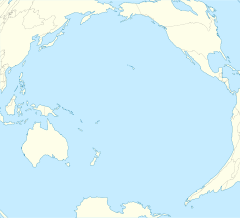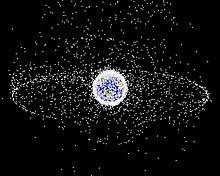
Atmospheric entry is the movement of an object from outer space into and through the gases of an atmosphere of a planet, dwarf planet, or natural satellite. There are two main types of atmospheric entry: uncontrolled entry, such as the entry of astronomical objects, space debris, or bolides; and controlled entry of a spacecraft capable of being navigated or following a predetermined course. Technologies and procedures allowing the controlled atmospheric entry, descent, and landing of spacecraft are collectively termed as EDL.

Salyut 7, also known as DOS-6 was a space station in low Earth orbit from April 1982 to February 1991. It was first crewed in May 1982 with two crew via Soyuz T-5, and last visited in June 1986, by Soyuz T-15. Various crew and modules were used over its lifetime, including 12 crewed and 15 uncrewed launches in total. Supporting spacecraft included the Soyuz T, Progress, and TKS spacecraft.

Space debris are defunct human-made objects in space – principally in Earth orbit – which no longer serve a useful function. These include derelict spacecraft, mission-related debris, and particularly numerous in-Earth orbit, fragmentation debris from the breakup of derelict rocket bodies and spacecraft. In addition to derelict human-made objects left in orbit, space debris includes fragments from disintegration, erosion, or collisions; solidified liquids expelled from spacecraft; unburned particles from solid rocket motors; and even paint flecks. Space debris represents a risk to spacecraft.

Kosmos 954 was a reconnaissance satellite launched by the Soviet Union in 1977. A malfunction prevented safe separation of its onboard nuclear reactor; when the satellite reentered the Earth's atmosphere the following year, it scattered radioactive debris over northern Canada, some of the debris landing in the Great Slave Lake next to Fort Resolution, NWT.

Upravlyaemy Sputnik Aktivnyy, or US-A, also known in the west as Radar Ocean Reconnaissance Satellite or RORSAT, was a series of 33 Soviet reconnaissance satellites. Launched between 1967 and 1988 to monitor NATO and merchant vessels using radar, the satellites were powered by nuclear reactors.

A graveyard orbit, also called a junk orbit or disposal orbit, is an orbit that lies away from common operational orbits. One significant graveyard orbit is a supersynchronous orbit well beyond geosynchronous orbit. Some satellites are moved into such orbits at the end of their operational life to reduce the probability of colliding with operational spacecraft and generating space debris.
Space environment is a branch of astronautics, aerospace engineering and space physics that seeks to understand and address conditions existing in space that affect the design and operation of spacecraft. A related subject, space weather, deals with dynamic processes in the solar-terrestrial system that can give rise to effects on spacecraft, but that can also affect the atmosphere, ionosphere and geomagnetic field, giving rise to several other kinds of effects on human technologies.
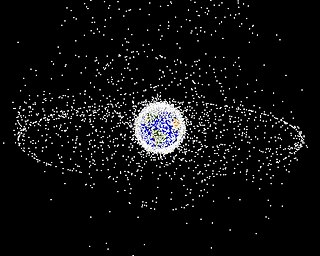
The Kessler syndrome, proposed by NASA scientists Donald J. Kessler and Burton G. Cour-Palais in 1978, is a scenario in which the density of objects in low Earth orbit (LEO) due to space pollution is numerous enough that collisions between objects could cause a cascade in which each collision generates space debris that increases the likelihood of further collisions. In 2009, Kessler wrote that modeling results had concluded that the debris environment was already unstable, "such that any attempt to achieve a growth-free small debris environment by eliminating sources of past debris will likely fail because fragments from future collisions will be generated faster than atmospheric drag will remove them". One implication is that the distribution of debris in orbit could render space activities and the use of satellites in specific orbital ranges difficult for many generations.
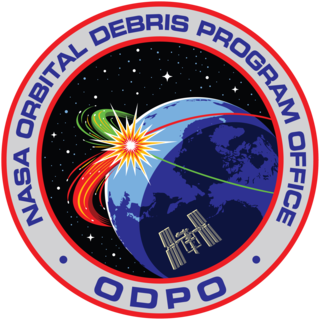
The NASA Orbital Debris Program Office is located at the Johnson Space Center and is the lead NASA center for orbital debris research. It is recognized world-wide for its leadership in addressing orbital debris issues. The NASA Orbital Debris Program Office has taken the international lead in conducting measurements of the environment and in developing the technical consensus for adopting mitigation measures to protect users of the orbital environment. Work at the center continues with developing an improved understanding of the orbital debris environment and measures that can be taken to control its growth.

Space advertising is the practice of advertising in space. This is usually done with product placements during crewed space missions.
Space policy is the political decision-making process for, and application of, public policy of a state regarding spaceflight and uses of outer space, both for civilian and military purposes. International treaties, such as the 1967 Outer Space Treaty, attempt to maximize the peaceful uses of space and restrict the militarization of space.
Spacecraft collision avoidance is the implementation and study of processes minimizing the chance of orbiting spacecraft inadvertently colliding with other orbiting objects. The most common subject of spacecraft collision avoidance research and development is for human-made satellites in geocentric orbits. The subject includes procedures designed to prevent the accumulation of space debris in orbit, analytical methods for predicting likely collisions, and avoidance procedures to maneuver offending spacecraft away from danger.

Tiangong-1 was China's first prototype space station. It orbited Earth from September 2011 to April 2018, serving as both a crewed laboratory and an experimental testbed to demonstrate orbital rendezvous and docking capabilities during its two years of active operational life.

Progress M1-5 was the Progress spacecraft which was launched by Russia in 2001 to deorbit the fifteen-year-old Mir space station in a controlled fashion over a remote area of the southern Pacific Ocean otherwise Mir's orbit would have decayed uncontrolled over time, with debris potentially landing in a populated area. The Russian Aviation and Space Agency, Rosaviakosmos, was responsible for the mission.

Human presence in space is the direct and mediated presence or telepresence of humans in outer space and in a broader sense also on any extraterrestrial astronomical body. Human presence in space, particularly through mediation, can take many physical forms from space debris, uncrewed spacecraft, artificial satellites, space observatories, crewed spacecraft, art in space, to human outposts in outer space such as space stations.

The Russian space station Mir ended its mission on 23 March 2001, when it was brought out of its orbit, entered the atmosphere and was destroyed. Major components ranged from about 5 to 15 years in age, and included the Mir Core Module, Kvant-1, Kvant-2, Kristall, Spektr, Priroda, and Docking Module. Although Russia was optimistic about Mir's future, the country's commitments to the International Space Station programme left no funding to support Mir.

Progress MS-01, identified by NASA as Progress 62P was a Progress spaceflight operated by Roscosmos to resupply the International Space Station (ISS) in 2015. It was launched on 21 December 2015, to deliver cargo to the ISS. Progress MS-01 is the first vehicle in the Progress-MS series.

Space sustainability aims to maintain the safety and health of the space environment, as well as planetary environments.
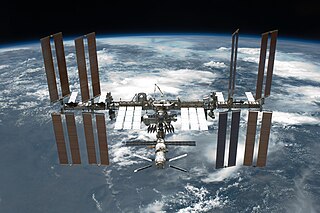
Space diplomacy refers to the integration of the collaboration of the knowledge, technology, and legislation involved in science diplomacy as applied to the expanded exploration of space. As diplomatic relationships are integral to the mitigation of various health, scientific, natural or technological issues across nations, space diplomacy is a growing field in which various nations can come to a consensus on what is fair when it comes to the exploration and commercialization of space travel.
